Abstract
In the present study, our focus is to obtain the different analytical solutions to the space–time fractional Bogoyavlenskii equation in the sense of the Jumaries-modified Riemann–Liouville derivative and to the conformable time–fractional-modified nonlinear Schrödinger equation that describes the fluctuation of sea waves and the propagation of water waves in ocean engineering, respectively. The –expansion method is applied to investigate the dynamics of solitons in relation to governing models. Moreover, the restriction conditions for the existence of solutions are reported. In addition, we note that the accomplished solutions are useful to the description of wave fluctuation and the wave propagation survey and are also significant for experimental and numerical verification in ocean engineering.
Keywords:
Jumaries-modified Riemann-Liouville derivative; conformable time-modified nonlinear Schrödinger equation; space–time fractional Bogoyavlenskii equation; MSC:
35Q53; 35C08; 37K40; 76B15
1. Introduction
Lately, it has become significant for scholars and researchers to investigate the analytical solutions to NLPDEs with the assistance of computational bundles, which simplify boring and tedious mathematical calculations. NLPDEs arise when one describes the physical mechanisms of natural phenomena in optical fibres, geochemistry, ocean engineering, geophysics, fluid mechanics, and many other fields. As a result, nonlinear phenomena are now, considered by many scholars in this novel field of science.
The nonlinear Schrödinger equation (NLSE), one of NLPDEs, has been investigated in such areas as nonlinear optics and condensed matter physics due to its potential physical applications and mathematical properties. It was found that the NLSE can illustrate the dynamic of nonlinear localized waves generally associated with breather, soliton, and rogue waves. Indeed, rogue waves can be informally thought of as rare events arising from the constructive interference of the surrounding waves. This construction interference can eventuate in waves with heights as large as ninth times that of the surrounding free surface. Multitude real-world consequences of these large spontaneous events exist, which can disrupt and damage human lives, commercial shipping, and many other nautical operations.
The modified nonlinear Schrödinger equation (MNSE) [1], which models rogue waves in ocean engineering, is given by
where , and and are the wave number and the frequency of the carrier wave, respectively.
The simplified form of this equation was first discovered by Rogister (1971), starting with a Vlasov kinetic explanation for the particle species. Next, it was proposed by Mjølhus (1976) and Mio et al. (1976) on the basis of Hall magnetohydrodynamics (MHD) for cold plasmas, and by Spangler and Sheerin (1982) and Sakai and Sonnerup (1983) from warm-fluid models.
The nonlinear spatio-temporal evolution of gravity water-surface waves can be predicted by the nonlinear Bogoyavlenskii equation. In 1990, the following NPDE was given, later called the Bogoyavlenskii equation [2], to describe some kinds of waves on the sea surface.
Fractional calculus (FC) was formulated in 1695 after the development of classical calculus. For a long time, FC was regarded as a pure mathematical area without any real applications, but over the last few decades FC was recognized as a useful tool for understanding and modeling several artificial and natural phenomena. Scientific areas where FC concepts are applied include not only physics and mathematics but also finance, human sciences, engineering, economics, chemistry, and biology.
Starting from the earlier stage of FCs, various fractional operators have been presented during the last 300 years. For instance, the Caputo derivative [3] appeared naturally in the work of Liouville and Abel, and it was proposed by Caputo to solve a practical problem.
The study of fractional-order nonlinear systems of physical models relies on the analysis of wave solutions for nonlinear equations. Recently, numerous and varied techniques have been used to solve nonlinear fractional equations, such as the functional variable method [4], the trial equation method and the modified trial method [5], and the bifurcation method [6].
The objective of the present paper is to apply an interesting method, namely, the –expansion method [7], to obtain novel exact solutions for the following nonlinear time-fractional equations:
- The conformable time-modified nonlinear Schrödinger equation (CTFMNLSE), given by [8]where , and are defined in Equation (1),
- The space–time fractional Bogoyavlenskii equation in the sense of the Jumarie’s modified the Riemann–Liouville derivative defined by [9]
2. The Basic Idea of the –Expansion Method
Here, we propose the algorithm of the –expansion procedure [7] for an NPDE, as follows:
• We assume a common nonlinear PDE of the type:
where
• Assume that the general solution of Equation (8) can be expressed in terms of as
where satisfies the following Riccati equation:
in which The passive constants or may be zero, but they cannot be zero at the same time. Note, are passive constants to be determined in the next step. Additionally, the value of can be computed through the homogeneous balance principle.
• Insert Equation (9), along with Equation (10), into Equation (8). Collect all of the coefficients of the same power of , and set all of the obtained coefficients to zero. Then, solve the system of algebraic equations on variables , and
• Based on and the solutions of Equation (10) are given by
Case 1:
Case 2:
Case 3:
where
3. Application of the –Expansion Method for Equations (1) and (4)
Consider CTFMNLSE (4), where is the conformable derivative of order given by [10]
in which is a given function.
If the above limit exists, then is called -differentiable. Assume and and are -differentiable at then we obtain the following results:
∘ where
∘, where
∘
∘
∘
∘
We start with the following traveling-wave assumption:
where ; ; and , and are the frequency, phase constant, and wave number, correspondingly. Inserting Equation (16) into Equation (4), we obtain the imaginary and real parts as [8]
and
By integrating the imaginary part and taking the constant equal to zero, we obtain
From the above, we have that
We can obtain the precise solution of Equation (19) in a similar way.
Balancing in Equation (22) with , we obtain the balancing number or
Suppose that the solution of Equation (22) can be given by
in which are constants to be determined later.
Inserting Equation (23) with Equation (10) into Equation (22) and collecting all of the terms with the same powers of and then equating every coefficient of the polynomial to zero, we obtain a system of algebraic equations, as follows:
Solving the above system of nonlinear algebraic equations, we have
Therefore, we obtain three types of traveling-wave solutions, as follows:
Case 1:
Case 2:
Case 3:
where
The Figure 1 and Figure 2 display the plots of Equation (30), for and two different cases and , respectively.

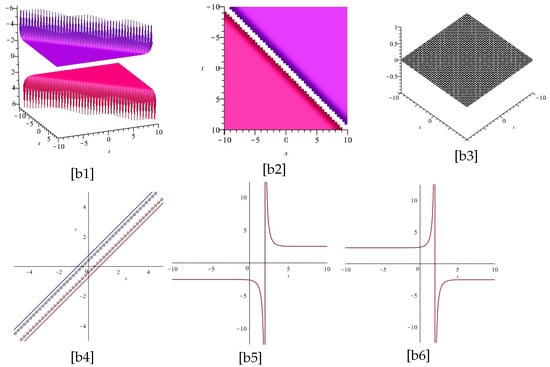
The Figure 3 and Figure 4 display the plots of Equation (30), for and two different cases and , respectively.
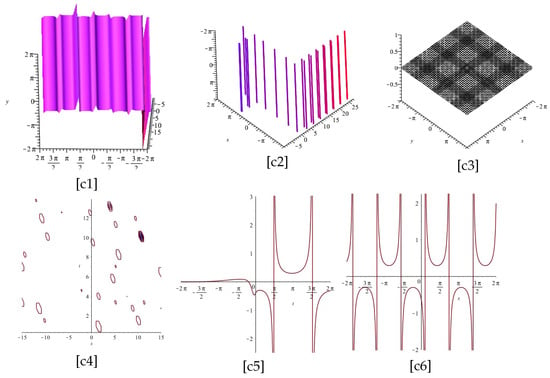
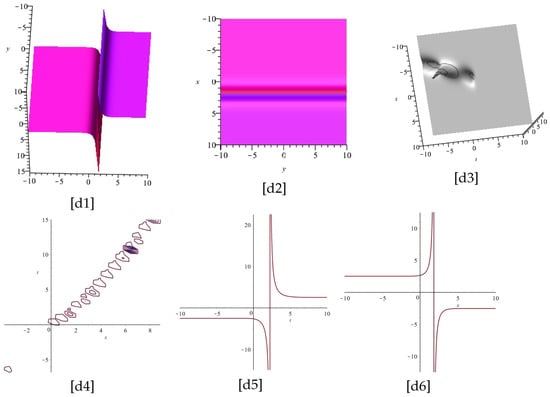
The Figure 5 and Figure 6 display the plots of Equation (30), for and two different cases and , respectively.
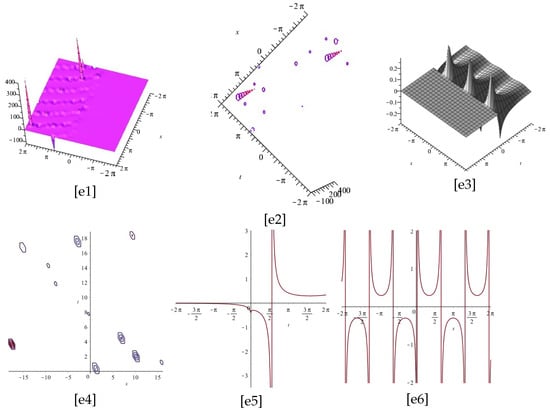
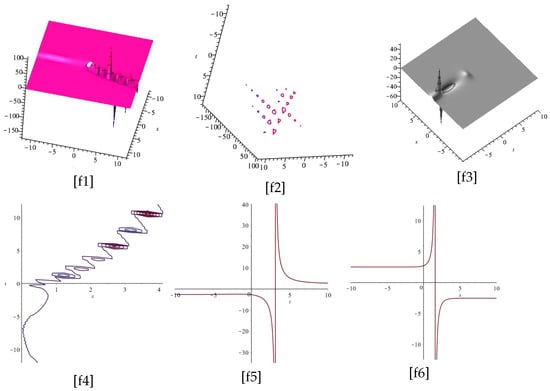
The Figure 7 and Figure 8 display the plots of Equation (30), for and two different cases and , respectively.
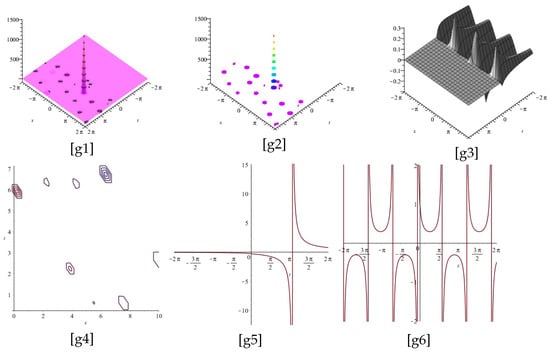
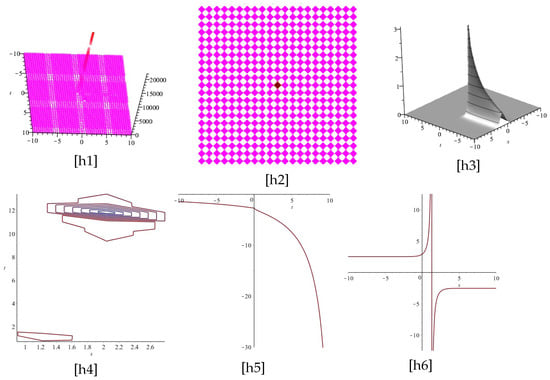
Notice that [1] and [3] are the imaginary and real part of Equation (30), and [2], [4], [5], and [6] display the z-axis orientation, the contour plot, the 2d for , and the 2d for , of the imaginary part of [1], respectively.
By considering Equation (25), we obtain three types of traveling-wave solutions, as follows:
Case 1:
Case 2:
Case 3:
where
In Figure 9, Figure 10, Figure 11 and Figure 12, the imaginary parts of Equation (34) are displayed for two different cases and , and different values of respectively.
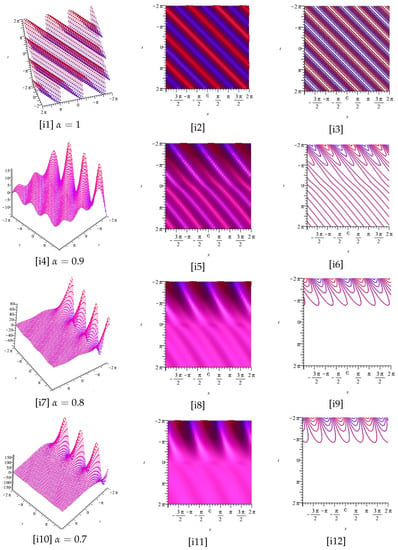
Figure 9.
Now, [i1], [i4], [i7], [i10] display the plots of the imaginary part of Equation (34), for , and [i2], [i5], [i8], [i11] as well as [i3], [i6], [i9], [i12] display the z-axis orientation and the contour plot, respectively.
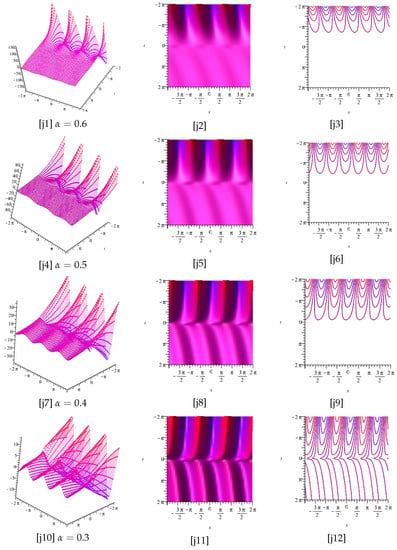
Figure 10.
Now, [j1], [j4], [j7], [j10] display the plots of the imaginary part of Equation (34), for , and [j2], [j5], [j8], [j11] as well as [j3], [j6], [j9], [j12] display the z-axis orientation and the contour plot, respectively.
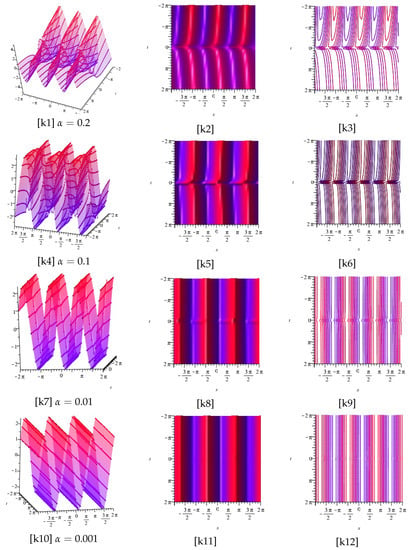
Figure 11.
Now, [k1], [k4], [k7], and [k10] display the plots of the imaginary part of Equation (34), for , and [k2], [k5], [k8], and [k11], as well as [k3], [k6], [k9], and [k12], display the z-axis orientation and the contour plot, respectively.
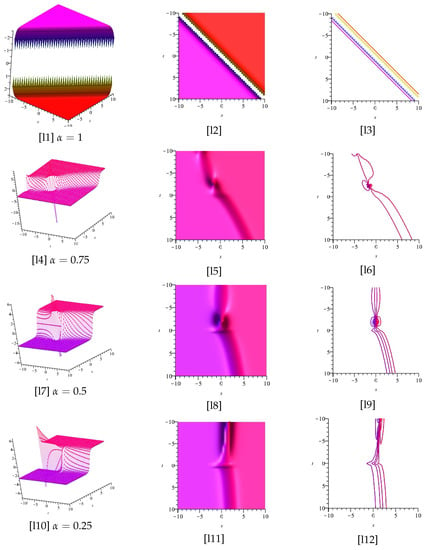
Figure 12.
Now, [l1], [l4], [l7], and [l10] display the plots of the imaginary part of Equation (34), for , and [l2], [l5], [l8], and [l11], as well as [l3], [l6], [l9], and [l12], display the z-axis orientation and the contour plot, respectively.
By considering Equation (26), we obtain three types of traveling-wave solutions, as follows:
Case 1:
Case 2:
Case 3:
where
In Figure 13 and Figure 14, the real part of Equation (38) is displayed for two different cases and , and different values of respectively.

Figure 13.
Now, [m1], [m4], [m7], and [m10] display the plots of the real part of Equation (38), for , and [m2], [m5], [m8], and [m11], as well as [m3], [m6], [m9], and [m12], display the z-axis orientation and the contour plot, respectively.
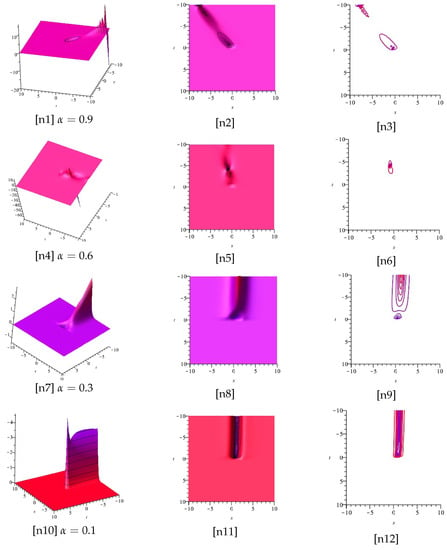
Figure 14.
Now, [n1], [n4], [n7], and [n10] display the plots of the real part of Equation (38), for , and [n2], [n5], [n8], and [n11], as well as [n3], [n6], [n9], and [n12], display the z-axis orientation and the contour plot, respectively.
3.1. Modulation Instability Analysis
Here, we deduce the modulation instability of Equation (4) for the special case through employing the criterion of linear stability analysis in [11].
Assume the steady-state solutions of Equation (4) for the special case which is given by
in which is the normalized optical power.
Assume that the solution to Equation (43) is as follows:
in which w is the frequency of perturbation and is the normalized wave number.
By inserting Equation (44) into Equation (43) and splitting the coefficients of and and solving the determinant of the coefficient matrix, we have
If
for any , then the steady-state is stable if the perturbations are small. In other words, small changes in the system input do not result in a large change in the system output. In addition, the steady-state solution is unstable if
here, w is imaginary, and the perturbation grows exponentially.
Therefore, the growth rate of the modulation stability gain spectrum is defined as
3.2. Discussion
The imaginary and real parts of solutions of Equation (4) are obtained by the -expansion method, whose diverse point sources, though arbitrary, and are displayed in Table 1, Table 2 and Table 3. As you can see, for fixed by changing , the expansion method results in minor changes for solutions . In other words, the mentioned solutions are stable against small perturbations. However, overall, for the governing method cannot properly describe all of the real parts of the solutions of Equation (4).

Table 1.
The imaginary and real parts of the analytical solutions of Equation (4) are obtained by the expansion method, with diverse point sources, though arbitrary, and .

Table 2.
The imaginary and real parts of the analytical solutions of Equation (4) are obtained by the -expansion method, with diverse point sources, though arbitrary, and .

Table 3.
The imaginary and real parts of the analytical solutions of Equation (4) are obtained by the expansion method, with diverse point sources, though arbitrary, and .
4. Application of the –Expansion Method for Equation (5)
Consider the time fractional Bogoyavlenskii Equation (5), where is the Jumaries-modified Riemann-Liouville derivative of order given by [12]
Some important properties of Jumarie’s derivative are
Through the following transformations:
integrating the second equation of Equation (5) once, and inserting the constant of integration to zero, we obtain
Now, setting the second equation of Equation (48) into the first equation, integrating the gained result with respect to , and substituting the integration constant to zero, we obtain
We now obtain the balancing number Suppose the solution of Equation (49) can be given by
in which are constants to be determined later.
Letting equation Equation (50) with Equation (10) into Equation (49), collecting all terms with the same powers of , and next equating every coefficient of the polynomial to zero, we obtain the following system of algebraic equations:
Solving the system of nonlinear algebraic equations, we have
Therefore, we obtain three types of traveling-wave solutions, as follows:
Case 1:
Case 2:
Case 3:
where
Therefore, we obtain three types of traveling-wave solutions, as follows:
Case 1:
Case 2:
Case 3:
where
Therefore, we obtain three types of traveling-wave solutions, as follows:
Case 1:
Case 2:
Case 3:
where
Therefore, we obtain three types of traveling-wave solutions, as follows:
Case 1:
Case 2:
Case 3:
where
5. Conclusions
We successfully obtained the different analytical solutions to the space–time fractional Bogoyavlenskii equation in the sense of the Jumaries-modified Riemann–Liouville derivative and the CTFMNLSE that describes the fluctuation of sea waves and the propagation of water waves in marine engineering, respectively. The gained results are very helpful in ocean sciences to understand the study of wave fluctuation and wave propagation and are also essential for the validity of experimental and numerical results. We displayed 2–D and 3–D plots for the better realization of the physical existence of the gained solutions by via the appropriate selection of the variables. These solutions are desirable for illustrating various natural phenomena. Our obtained solutions represented that the presented method can be applied to obtain analytical solutions for diverse kinds of NLPDEs.
Author Contributions
All of the authors conceived of the study, participated in its design and coordination, drafted the manuscript, and participated in the sequence alignment. All authors have read and agreed to the published version of the manuscript.
Funding
This research received no external funding.
Data Availability Statement
Not applicable.
Acknowledgments
The fourth author extends his appreciation to the Deanship of Scientific Research at Imam Mohammad Ibn Saud Islamic University (IMSIU) for funding and supporting this work through Research Partnership Program no RP-21-09-08.
Conflicts of Interest
The authors declare no conflict of interest.
References
- Rezapour, S.; Günay, B.; Al Shamsi, H.; Nonlaopon, K. On soliton solutions of a modified nonlinear Schrödinger’s equation of third-order governing in optical fibers. Results Phys. 2022, 41, 105919. [Google Scholar] [CrossRef]
- Al-Askar, F.M.; Mohammed, W.W.; Albalahi, A.M.; El-Morshedy, M. The influence of noise on the solutions of fractional stochastic bogoyavlenskii equation. Fractal Fract. 2022, 6, 156. [Google Scholar] [CrossRef]
- Aderyani, S.R.; Saadati, R.; Abdeljawad, T.; Mlaiki, N. Multi-stability of non homogenous vector-valued fractional differential equations in matrix-valued Menger spaces. Alex. Eng. J. 2022, 61, 10913–10923. [Google Scholar] [CrossRef]
- Guo, W.; Yang, Z.; Feng, Q.; Dai, C.; Yang, J.; Lei, X. A new method for band gap analysis of periodic structures using virtual spring model and energy functional variational principle. Mech. Syst. Signal Process. 2022, 168, 108634. [Google Scholar] [CrossRef]
- Hu, J.Y.; Feng, X.B.; Yang, Y.F. Optical envelope patterns perturbation with full nonlinearity for Gerdjikov–Ivanov equation by trial equation method. Optik 2021, 240, 166877. [Google Scholar] [CrossRef]
- Elmandouh, A.A.; Elbrolosy, M.E. New traveling-wave solutions for Gilson-Pickering equation in plasma via bifurcation analysis and direct method. Math. Methods Appl. Sci. 2022. [Google Scholar] [CrossRef]
- Urazboev, G.U.; Baltaeva, I.I.; Rakhimov, I.D. The Generalized (G′/G)-Expansion Method for the Loaded Korteweg–de Vries Equation. J. Appl. Ind. Math. 2021, 15, 679–685. [Google Scholar] [CrossRef]
- Aderyani, S.R.; Saadati, R.; Vahidi, J.; Allahviranloo, T. The exact solutions of the conformable time-fractional modified nonlinear Schrödinger equation by the Trial equation method and modified Trial equation method. Adv. Math. Phys. 2022, 2022, 4318192. [Google Scholar] [CrossRef]
- Alam, M.N.; Tunç, C. The new solitary wave structures for the (2 + 1)-dimensional time-fractional Schrodinger equation and the space–time nonlinear conformable fractional Bogoyavlenskii equations. Alex. Eng. J. 2020, 59, 2221–2232. [Google Scholar] [CrossRef]
- Wang, K.J.; Shi, F.; Liu, J.H.; Si, J. Application of the extended F-expansion method for solving the fractional Gardner equation with conformable fractional derivative. Fractals 2022, 30, 1–11. [Google Scholar] [CrossRef]
- Chen, Q.; Baskonus, H.M.; Gao, W.; Ilhan, E. Soliton theory and modulation instability analysis: The Ivancevic option pricing model in economy. Alex. Eng. J. 2022, 61, 7843–7851. [Google Scholar] [CrossRef]
- Radhakrishnan, B.; Tamilarasi, M. A new approach for the generalized fractional Casson fluid model with Newtonian heating described by the modified Riemann-Liouville fractional operator. Math. Methods Appl. Sci. 2022, 45, 3574–3588. [Google Scholar] [CrossRef]
Disclaimer/Publisher’s Note: The statements, opinions and data contained in all publications are solely those of the individual author(s) and contributor(s) and not of MDPI and/or the editor(s). MDPI and/or the editor(s) disclaim responsibility for any injury to people or property resulting from any ideas, methods, instructions or products referred to in the content. |
© 2022 by the authors. Licensee MDPI, Basel, Switzerland. This article is an open access article distributed under the terms and conditions of the Creative Commons Attribution (CC BY) license (https://creativecommons.org/licenses/by/4.0/).